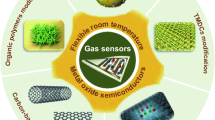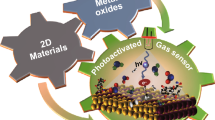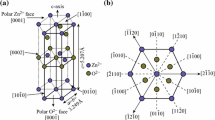Abstract
A new structure of a polymer composite was designed to be used as a vapor sensor for detection of a set of volatile organic compounds (VOCs), namely ethanol, methanol, isopropyl alcohol (IPA), toluene and water as moisture in the atmosphere. Picric acid was used for physical decoration of graphene (Gr), as a conductive filler, and then, the modified graphene (Gr.PA) was added to polyvinyl alcohol (PVA) to design a conductive polymer composite (CPC) sensitive layer for detection of polar vapor analytes. The Fourier transfer infrared spectroscopy (FTIR) was used to study the physical adsorption of picric acid molecules on the surface of Gr. The experimental results revealed that the sensitivity of the prepared CPC transducer was dramatically improved through the decoration of Gr surfaces with PA molecules. The enhanced sensitivity was related to the addition of –OH and –NO2 functional groups on the surface of Gr (due to picric acid molecules). Those polar functional groups increased the diffusion driving force of polar analytes into the polymer composite. On the other hand, upon adding PA molecules, Gr–Gr junctions were tuned as sensitive sites, and the adsorbed vapor molecules increased the distance of Gr platelets, which, consequently, decreased the electron tunneling conductivity of the prepared CPC. The experimental results also proved that one could change the electrical conductivity of Gr as a p-type semiconductor through adsorption of analyte molecules on its surface. All in all, the attained results demonstrated that tuning the conductive filler junctions could be regarded as an exceptional strategy to improve the sensitivity of CPC transducers.








Similar content being viewed by others
References
Bearzotti A, Macagnano A, Papa P, Venditti I, Zampetti E (2017) A study of a QCM sensor based on pentacene for the detection of BTX vapors in air. Sens Actuators B 240:1160–1164
Spinelle L, Gerboles M, Kok G, Persijn S, Sauerwald T (2017) Review of portable and low-cost sensors for the ambient air monitoring of benzene and other volatile organic compounds. Sensors 17:1520
Caron A, Redon N, Thevenet F, Hanoune B, Coddeville P (2016) Performances and limitations of electronic gas sensors to investigate an indoor air quality event. Build Environ 107:19–28
Vanderroost M, Ragaert P, Devlieghere F, De Meulenaer B (2014) Intelligent food packaging: the next generation. Trends Food Sci Technol 39:47–62
Esser B, Schnorr JM, Swager TM (2012) Selective detection of ethylene gas using carbon nanotube-based devices: utility in determination of fruit ripeness. Angew Chem Int Ed 51:5752–5756
Pan L, Zhang W, Zhu N, Mao S, Tu K (2014) Early detection and classification of pathogenic fungal disease in post-harvest strawberry fruit by electronic nose and gas chromatography-mass spectrometry. Food Res Int 62:162–168
Casalinuovo I, Di Pierro D, Coletta M, Di Francesco P (2006) Application of electronic noses for disease diagnosis and food spoilage detection. Sensors 6:1428–1439
Buszewski B, Kęsy M, Ligor T, Amann A (2007) Human exhaled air analytics: biomarkers of diseases. Biomed Chromatogr 21:553–566
Neethirajan S, Jayas D, Sadistap S (2009) Carbon dioxide (CO2) sensors for the agri-food industry—a review. Food Bioprocess Technol 2:115–121
Tanguy NR, Thompson M, Yan N (2018) A review on advances in application of polyaniline for ammonia detection. Sens Actuators B 257:1044–1064
Lonergan MC, Severin EJ, Doleman BJ, Beaber SA, Grubbs RH, Lewis NS (1996) Array-based vapor sensing using chemically sensitive, carbon black-polymer resistors. Chem Mater 8:2298–2312
Dey A (2018) Semiconductor metal oxide gas sensors: a review. Mater Sci Eng B 229:206–217
Slobodian P, Riha P, Lengálová A, Svoboda P, Sáha P (2011) Multi-wall carbon nanotube networks as potential resistive gas sensors for organic vapor detection. Carbon 49:2499–2507
Wang T, Huang D, Yang Z, He G, Li X, Hu N, Yin G, He D, Zhang L (2016) A review on graphene-based gas/vapor sensors with unique properties and potential applications. NanoMicro Lett 8:95–119
Wang X, Li Y, Pionteck J, Zhou Z, Weng W, Luo X, Qin Z, Voit B, Zhu M (2018) Flexible poly (styrene-butadiene-styrene)/carbon nanotube fiber based vapor sensors with high sensitivity, wide detection range, and fast response. Sens Actuators B 256:896–904
Fan Q, Qin Z, Villmow T, Pionteck J, Pötschke P, Wu Y, Voit B, Zhu M (2011) Vapor sensing properties of thermoplastic polyurethane multifilament covered with carbon nanotube networks. Sens Actuators B 156:63–70
Feller JF, Lu J, Zhang K, Kumar B, Castro M, Gatt N, Choi HJ (2011) Novel architecture of carbon nanotube decorated poly (methyl methacrylate) microbead vapour sensors assembled by spray layer by layer. J Mater Chem 21:4142–4149
Alizadeh T, Soltani LH (2013) Graphene/poly (methyl methacrylate) chemiresistor sensor for formaldehyde odor sensing. J Hazard Mater 248:401–406
Tripathi KM, Kim T, Losic D, Tung TT (2016) Recent advances in engineered graphene and composites for detection of volatile organic compounds (VOCs) and non-invasive diseases diagnosis. Carbon 110:97–129
Molla-Abbasi P, Reza Ghaffarian S, Dashtimoghadam E (2016) Wrapping carbon nanotubes by biopolymer chains: role of nanointerfaces in detection of vapors in conductive polymer composite transducers. Polym Compos 37:2803–2810
Qi H, Liu J, Pionteck J, Pötschke P, Mäder E (2015) Carbon nanotube–cellulose composite aerogels for vapour sensing. Sens Actuators B 213:20–26
Bouvree A, Feller JF, Castro M, Grohens Y, Rinaudo M (2009) Conductive polymer nano-biocomposites (CPC): chitosan-carbon nanoparticle a good candidate to design polar vapour sensors. Sens Actuators B 138:138–147
Tung TT, Nine MJ, Krebsz M, Pasinszki T, Coghlan CJ, Tran DN, Losic D (2017) Recent advances in sensing applications of graphene assemblies and their composites. Adv Funct Mater 27:1702891
Castro M, Lu J, Bruzaud S, Kumar B, Feller JF (2009) Carbon nanotubes/poly(ε-caprolactone) composite vapour sensors. Carbon 47:1930–1942
He Q, Wu S, Yin Z, Zhang H (2012) Graphene-based electronic sensors. Chem Sci 3:1764–1772
Yavari F, Koratkar N (2012) Graphene-based chemical sensors. J Phys Chem Lett 3:1746–1753
Huang L, Wang Z, Zhang J, Pu J, Lin Y, Xu S, Shen L, Chen Q, Shi W (2014) Fully printed, rapid-response sensors based on chemically modified graphene for detecting NO2 at room temperature. ACS Appl Mater Interface 6:7426–7433
Chen Z, Umar A, Wang S, Wang Y, Tian T, Shang Y, Fan Y, Qi Q, Xu D, Jiang L (2015) Supramolecular fabrication of multilevel graphene-based gas sensors with high NO2 sensibility. Nanoscale 7:10259–10266
Zheng Y, Lee D, Koo HY, Maeng S (2015) Chemically modified graphene/PEDOT:PSS nanocomposite films for hydrogen gas sensing. Carbon 81:54–62
Yuan W, Liu A, Huang L, Li C, Shi G (2013) High-performance NO2 sensors based on chemically modified graphene. Adv Mater 25:766–771
Mann JA, Dichtel W (2013) Noncovalent functionalization of graphene by molecular and polymeric adsorbates. J Phys Chem Lett 4:2649–2657
Georgakilas V, Tiwari JN, Kemp KC, Perman J, Bourlinos A, Kim K, Zboril R (2016) Noncovalent functionalization of graphene and graphene oxide for energy materials, biosensing, catalytic, and biomedical applications. Chem Rev 116:5464–5519
Emiru TF, Ayele DW (2017) Controlled synthesis, characterization and reduction of graphene oxide: a convenient method for large scale production. Egypt J Basic Appl Sci 4:74–79
Parmar AK, Valand NN, Solanki KB, Menon SK (2016) Picric acid capped silver nanoparticles as a probe for colorimetric sensing of creatinine in human blood and cerebrospinal fluid samples. Analyst 141:1488–1498
Molla-Abbasi P, Shabanian M (2019) A bulky aromatic functional polyimide composite as a sensitive layer for the detection of organic compound biomarkers. Iran Polym J 28:203–211
Molla-Abbasi P, Ghaffarian SR (2014) Decoration of carbon nanotubes by chitosan in a nanohybrid conductive polymer composite for detection of polar vapours. RSC Adv 4:30906–30913
Hansen CM (2007) Solubility parameters: a user's handbook. CRC, Boca Raton
Nag S, Castro M, Choudhary V, Feller JF (2017) Sulfonated poly (ether ether ketone)[SPEEK] nanocomposites based on hybrid nanocarbons for the detection and discrimination of some lung cancer VOC biomarkers. J Mater Chem B 5:348–359
Nag S, Duarte L, Bertrand E, Celton V, Castro M, Choudhary V, Guegan Ph, Feller JF (2014) Ultrasensitive QRS made by supramolecular assembly of functionalized cyclodextrins and graphene for the detection of lung cancer VOC biomarkers. J Mater Chem B 2:6571–6579
Knite M, Shakale G, Klemenoks I, Ozols K, Teteris V (2007) Investigation of mechanism of organic solvent vapours sensing effect in polyisoprene-high structure carbon black composite. In: Paper presented at journal of physics: conference series, vol 93, no. 1
Putri LK, Ong WJ, Chang WS, Chai SP (2015) Heteroatom doped graphene in photocatalysis: a review. Appl Surf Sci 358:2–14
Wang Z, Nayak PK, Caraveo-Frescas JA, Alshareef HN (2016) Recent developments in p-type oxide semiconductor materials and devices. Adv Mater 28:3831–3892
Lee YH, Jang M, Lee MY, Kweon OY, Oh JH (2017) Flexible field-effect transistor-type sensors based on conjugated molecules. Chemistry 3:724–763
Kumar B, Castro M, Feller JF (2012) Controlled conductive junction gap for chitosan–carbon nanotube quantum resistive vapour sensors. J Mater Chem 22:10656–10664
Li J, Lu Y, Ye Q, Cinke M, Han J, Meyyappan M (2003) Carbon nanotube sensors for gas andorganic vapor detection. Nano Lett 3:929–933
Author information
Authors and Affiliations
Corresponding author
Electronic Supplementary Material
Below is the link to the electronic supplementary material.
Rights and permissions
About this article
Cite this article
Soleimani, E., Aghamiri, S.F., Molla-Abbasi, P. et al. Tuning the polymer–graphene interfaces by picric acid molecules to improve the sensitivity of a prepared conductive polymer composite gas detector. Iran Polym J 29, 341–350 (2020). https://doi.org/10.1007/s13726-020-00800-0
Received:
Accepted:
Published:
Issue Date:
DOI: https://doi.org/10.1007/s13726-020-00800-0




